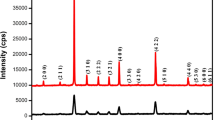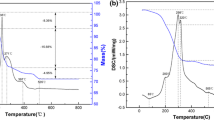Abstract
Polycrystalline ceramic samples of Bi4V2−xMexO11 (Me = Nb, Zr, Y and Cu and x = 0.0 and 0.02) have been synthesized by standard solid state reaction method using high purity oxides. The formation of the compounds have been analysed by X-ray diffraction method. The dielectric constant, dielectric loss and AC conductivity as a function of frequency and temperature have been measured. The dielectric studies indicate that the material is highly lossy and hence its AC conductivity increases with the increase of temperature. The DC conductivity of material has been measured as a function of temperature from room temperature to 380 °C and its activation energy was calculated using the relation σ = σ 0exp (−E a/kT). The modulated differential scanning calorimetry has been used to investigate the effect of substitution on the heat capacity and heat flow of the compounds. The results are discussed in detail.












Similar content being viewed by others
References
Abraham F, Debreuille-Gresse MF, Mairesse G, Nowogrocki G. Phase transitions and ionic conductivity in Bi4V2O11 an oxide with a layered structure. Solid State Ionics. 1988;28–30:529–32.
Abraham F, Boivin JC, Mairesse G, Nowogrocki G. The bimevox series: a new family of high performances oxide ion conductors. Solid State Ionics. 1990;40–41:934–7.
Prasad KVR, Varma KBR. Pyroelectric properties of Bi2VO5.5 ceramic. J Phys D Appl Phys. 1991;24:1858–60.
Prasad KVR, Varma KBR. Dielectric, thermal and pyroelectric properties of ferroelectric bismuth vanadate single crystals. Mater Chem Phys. 1994;38:406–10.
Cherrak A, Hubaut R, Barbaux Y, Mairresse G. Catalytic properties of bismuth vanadates based catalysts in oxidative coupling of methane and oxidative dehydrogenation of propane. Catal Lett. 1992;15:377–83.
Avakyan PB, Nersesyam MD, Merzhanov AG. New materials for electronic engineering. Am Ceram Soc Bull. 1996;75:50–5.
Shuk P, Wiemhofer HD, Guth U, Gopel W, Greenblatt M. Oxide ion conducting solid electrolytes based on Bi2O3. Solid State Ionics. 1996;89:179–96.
Arroyoyde Dompablo ME, Garcia Alvarado F, Moran E. Bi4V2O11 and related compounds as positive electrode materials for lithium rechargeable batteries. Solid State Ionics. 1996;91:273–8.
Pasciak G, Chmielowiec J, Bujlo P. New ceramic superionic materials for IT-SOFC applications. Mater Sci Pol. 2005;23:209–19.
Pell JW, Ying JY, Zur Loye H. Sol–gel synthesis of α-Bi2VO5.5 using a soluble bismuth precursor. Mater Lett. 1995;25:157–60.
Hervoches CH, Steil M, Muccillo R. Synthesis by the polymeric precursor technique of Bi2Co0.1V0.9O5.35 and electrical properties dependence on the crystallite size. Solid State Sci. 2004;6:173–7.
Castro A, Millan P, Ricote J, Pardo L. Room temperature stabilisation of γ-Bi2VO5.5 and synthesis of the new fluorite phase f-Bi2VO5 by a mechanochemical activation method. J Matter Chem. 2000;10:767–71.
Roy B, Fuierer P. Synthesis of cobalt-doped bismuth vanadate by combustion synthesis: influence of fuel on phase content and morphology. J Mater Res. 2009;24:3078–86.
Roy B, Fuierer P. Molten salt synthesis of Bi4 (V0.85Co0.15)2O11−δ (BICOVOX) ceramic powders. J Am Ceram Soc. 2009;92:520–3.
Kant R, Singh K, Pandey OP. Microstructure and electrical behavior of Bi4V2−xCuxO11−δ (0 ≤ x ≤ 0.4). Ceram Int. 2009;35:221–7.
Barreca D, Depero LE, Dinoto V, Rizzi GA, Sangaletti L, Tondello E. Thin films of bismuth vanadates with modifiable conduction properties. Chem Mater. 1999;11:255–61.
Joubert O, Jouanneaux A, Ganne M. Crystal structure of low-temperature form of bismuth vanadium oxide determined by rietveld refinement of X-ray and neutron diffraction data α- Bi4V2O11. Mater Res Bull. 1994;29:175–84.
Garcia Gonzalez E, Arribas M, Gonzalez Calbet JM. Oxygen content and microstructure in Bi4V2O11−δ. J Mater Chem. 2001;11:2320–3.
Vannier RN, Mairesse G, Abraham F, Nowogrocki G, Pernot E, Anne M, Bacmann M, Strobel P, Fouletier J. Thermal behaviour of Bi4V2O11: X-ray diffraction and impedance spectroscopy studies. Solid State Ionics. 1995;78:183–9.
Vannier RN, Pernot E, Anne M, Isnard O, Nowogrocki G, Mairesse G. Bi4V2O11 polymorph crystal structures related to their electrical properties. Solid State Ionics. 2003;157:147–53.
Achary SN, Mathews MD, Patwe SJ, Tyagi AK. High-temperature X-ray diffraction and dilatometric studies on some oxygen ion conducting compounds. J Mater Sci Lett. 1999;18:355–7.
Pirovano C, Steil MC, Capoen E, Novogrocki G, Vannier RN. Impedance study of the microstructure dependence of the electrical properties of BIMEVOXes. Solid State Ionics. 2005;176:2079–83.
Dygas JR, Malys M, Krok F, Wrobel W, Kozanecka A, Abrahams I. Polycrystalline BIMGVOX.13 studied by impedance spectroscopy. Solid State Ionics. 2005;176:2085–93.
Roy M, Bala I, Barbar SK. Synthesis, structural, electrical and thermal properties of Ti-doped Bi2Sn2O7 pyrochlore. J Therm Anal Calorim. 2012;110:559–65.
Shantha K, Varma KBR. Diffused phase transition in fine-grained bismuth vanadate ceramics. J Mater Res. 1999;14:4651–6.
Paydar MH, Hadian AM, Fafilek G. Studies on preparation, characterisation and ion conductivity of TI-CU double substituted Bi4V2O11. J Eur Ceram Soc. 2001;21:1821–4.
Buyanova ES, Zhukovskii VM, Loputina ES, Ivanovskaya VV, Raitenko EA. Synthesis and electrical properties of solid solution of bismuth vanadate. Inorg Mater. 2002;38:256–60.
YuV Emel’yanova, Shafigina RR, Buyanova ES, Zhukovskii VM, Zainullina VM, Petrova SA. Oxide ion conductors of the BIMEVOX family: synthesis, structure, and conductivity. Russ J Phys Chem. 2006;80:1725–30.
Zhukovskii VM, Emel’yanova YV, Shafigina RR, Petrova SA, Zainullina VM, Buyanova ES. Oxide ceramics BIMEVOX: conductivity, structure, and chemical bond. Russ J Phys Chem. 2007;43:443–7.
Kant R, Singh K, Pandey OP. Synthesis and characterization of bismuth vanadate electrolyte material with aluminium doping for SOFC application. Int J Hydrogen Energy. 2008;33:455–62.
Beg S, Hafeez S, Al-Areqi NAS. Influence of calcium substitution on the phase transition and ionic conductivity in BICAVOX oxide ion conductor. Phase Transit. 2010;83:169–81.
Fuierer P, Maier R, Roder Roith U, Moos R. Processing issues related to the bi-dimensional ionic conductivity of BIMEVOX ceramic. J Mater Sci. 2011;46:5447–53.
Touboul M, Lokaj J, Tessier L, Kettman V, Vrabel V. Structure of dibismuth vanadate Bi2VO5.5. Acta Crystallogr. 1992;C48:1176–9.
Author information
Authors and Affiliations
Corresponding author
Rights and permissions
About this article
Cite this article
Roy, M., Sahu, S., Barbar, S.K. et al. Synthesis, electrical and thermal properties of Bi4V2−xMexO11 (x = 0.0 and 0.02) ceramics. J Therm Anal Calorim 113, 873–879 (2013). https://doi.org/10.1007/s10973-012-2833-1
Received:
Accepted:
Published:
Issue Date:
DOI: https://doi.org/10.1007/s10973-012-2833-1




